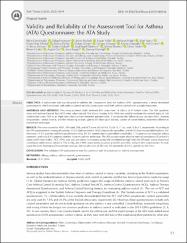Validity and reliability of the assessment tool for Asthma (ATA) questionnaire: the ATA study

Göster/
Erişim
info:eu-repo/semantics/openAccessTarih
2020Yazar
Gemicioğlu, BilunMungan, Dilşad
Bavbek, Sevim
Yıldız, Füsun
Polatlı, Mehmet
Naycı, Sibel
Erkekol, Ferda Öner
Türker, Hatice
Günen, Hakan
Çamsan, Güngör
Abadoğlu, Öznur
Çımrın, Arif
Dursun, Adile Berna
Göksel, Özlem
Özdemir, Seçil Kepil
Börekçi, Şermin
Aydın, Ömür
Ocaklı, Birsen
Gür, Aygün
Baygül, Arzu
Mısırlıgil, Zeynep
Üst veri
Tüm öğe kaydını gösterKünye
Gemicioğlu, B., Mungan, D., Bavbek, D., Yıldız, F., Polatlı, M., Naycı, S. ve diğerleri. (2019). Validity and reliability of the assessment tool for Asthma (ATA) questionnaire: the ATA study. Turkish Thoracic Journal, 21(2), 93-99.Özet
OBJECTIVES: A multicenter trial was designed to validate the “Assessment Tools for Asthma (ATA)” questionnaire, a newly developed questionnaire, which evaluates both asthma control and risk factors associated with asthma control with a single instrument. MATERIALS AND METHODS: This cross-sectional study involved 810 cases from 14 clinics in 9 Turkish cities. The ATA questionnaire and Asthma Control Test (ACT) were administered. The Visual Analog Scale (VAS) was used to evaluate the control status of 100 randomized cases. ATA is an eight-item physician-administered questionnaire. It comprises the following two sections-ATA1, assesses symptomatic control criteria, and the remaining section, queries the flre-up of asthma, control of comorbidities, treatment adherence, and inhaler technique. RESULTS: The mean scores for ATA1, ATA total, VAS, and ACT were 24.7±14.8, 53.8±19, 7.1±3, and 18.8±5.5, respectively. According to the ATA questionnaire, among all patients, 34.3% had controlled, 18.8% had partly controlled, and 46.9% had uncontrolled asthma. Furthermore, 16.6% patients had flre-ups between visits, 96.4% patients had uncontrolled comorbidity, 17% patients had irregular asthma treatment, and only 8.4% patients used the incorrect inhaler technique. The ATA questionnaire showed internal consistency (Cronbach’s alpha coeffiient=0.683). ACT, ATA1, and two specialists’ evaluations using VAS correlated strongly with the ATA total scores (Spearman correlation coeffiient (r) values: 0.776, 0.783, and 0.909, respectively; p-values: p<0.001, p<0.001, and p<0.001, respectively). According to Receiver Operating Characteristic analysis, the cut-off value of ATA was 50 (sensitivity=84.4%, specifiity=82.40%). CONCLUSION: The validated ATA questionnaire may be a practical tool for physicians in asthma management.
Kaynak
Turkish Thoracic JournalCilt
21Sayı
2Bağlantı
https://doi.org/10.5152/TurkThoracJ.2019.180186https://app.trdizin.gov.tr/makale/TXpZd05qVTJOZz09
https://hdl.handle.net/11436/5769

















